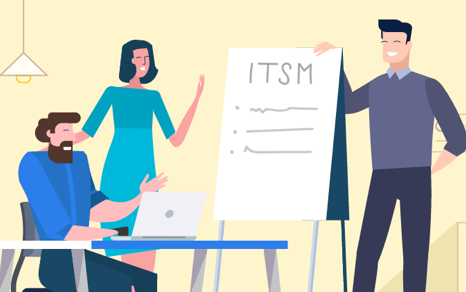Visualization
The ability to quickly and easily visualize process workflows is one of the key benefits of implementing ITSM. Managers can identify bottlenecks and pinpoint where a process needs to be simplified—by rearranging steps, eliminating repetitive ones, and/or automating them.
Then they can run cost-benefit analyses to determine if a procedural change will actually save time and money. This information helps them further streamline IT service delivery and spot gaps in functionality, so they know how to budget for evolving technology needs.
ITSM tools also let managers visualize agent performance metrics, including average response time, process compliance, success rates, and customer satisfaction scores—all in one place. This way, they can easily identify (and reward) high achievers and determine which agents need additional support and training, thus improving the overall quality of IT customer service.
Better Customer Service Experience
While most of your organization focuses on providing the best possible customer experience, your IT organization is responsible for ensuring they have the technology they need to do it. IT's customers are internal, and they’re a demanding bunch. After all, when their technology isn’t working, neither can they. They don’t know (or care) about all the other tickets and tasks that your tech team needs to handle; they just know they need their tools to work ASAP.
One of the many employee-facing ITSM benefits is transparency. Users have access to the IT service catalog, so they know what types of services they can request and how to request them. They can see where their ticket is in the service queue and, thanks to automated workflows, get an estimate of their wait time.
Because agent productivity is one of the chief benefits of ITSM, that wait time is shorter than ever. This is especially true if their need is urgent because ITSM ticketing systems prioritize the most mission-critical requests. And if their need is easy to resolve, they don’t have to wait at all, because an AI chatbot can walk them through the steps they need to take to solve the problem themselves.
All this automation improves IT customer satisfaction, which in turn improves IT agent satisfaction. Instead of being frustrated with IT because they’re not solving problems fast enough, employees gain a better understanding of just how much the IT department is responsible for and they get their problems solved faster than ever. All of this helps to position IT as the MVPs that management already knows they are.
Clear Communication Channels
ITSM solutions improve collaboration between IT and other business functions. IT users can easily request services through the incident reporting (ticketing) system, and all their feedback on products and services gets captured in one place so IT leaders can keep improving service delivery.
Yet, while all requests go through one platform, employees can access that platform—and IT services—in a variety of ways, via the channel of their choice. This increasingly includes live chat, which is not only the preferred channel for many IT users but is often the most efficient way to receive services. In recent years, the annual Freshservice Benchmark Report has consistently noted that when IT users submit service requests via live chat, their issues get resolved twice as fast.
Even better, they can chat via the same collaboration tools that they use to communicate with everyone else on their teams. They don’t have to learn a new system or even open a new browser tab. They can instead just start a new chat in an app they’re already using. For example, Freshservice includes native integrations with popular apps such as Microsoft Team, Slack, and WhatsApp, and enables easy API integration with other apps.
Less Risky IT Changes
Change management is an important part of ITSM frameworks and solutions. That’s because change is key to innovation, but it can also be risky. Unless changes are well planned, thoroughly tested, and effectively communicated to stakeholders, they can cause more harm than good, resulting in significant business or service interruptions.
ITSM tools enable tech teams to visualize (and thus avoid) the risks associated with any change, formalize low-risk processes to implement the change, and clearly communicate the change to everyone involved.
As Freshworks CIO Prasad Ramakrishnan puts it, "Having tools that allow rapid deployment of process changes is equally important for IT and the business to realize value faster."
ITSM Benefits Beyond IT
Your IT department isn’t the only team that can experience the benefits of ITSM. Other employee-facing departments—such as HR, legal, finance, and facilities management—also provide services to internal customers. They, too, need a way to manage those services, streamline communications, and automate workflows.
With some tweaks, leading ITSM solutions can be used as Enterprise Service Management (ESM) for other departments that serve internal customers. They can create their own service catalogs and knowledge bases. In addition, they can maintain their own intelligent ticketing systems, gain visibility into their processes, and automate some of their workflows.
If your solutions provider offers both ITSM and ESM capabilities, all these different teams can use the same platform as your IT department. This simplifies customer service because employees can use one system to request all the support they need from different departments. It makes things easier for IT because they only have one service management tool to maintain. And it reduces costs for your business because you only have to pay one vendor for the benefits of implementing ITSM across multiple departments.






